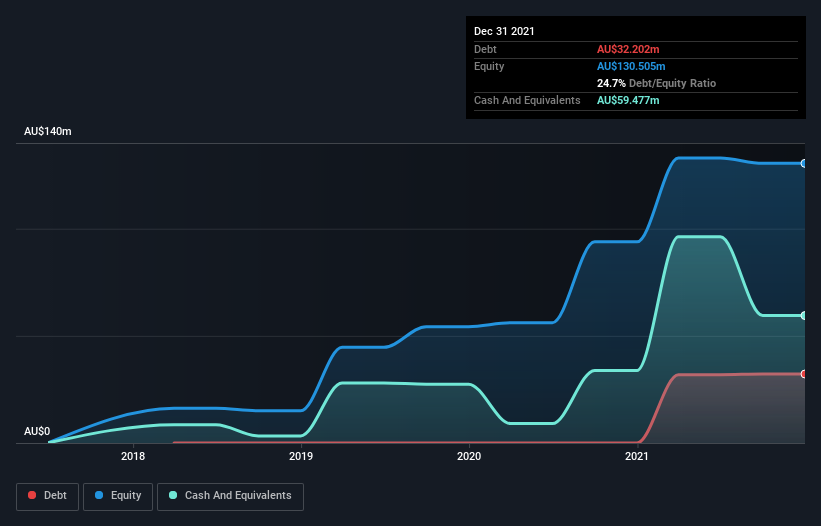Legendary fund manager Li Lu (who Charlie Munger backed) once said, 'The biggest investment risk is not the volatility of prices, but whether you will suffer a permanent loss of capital.' So it might be obvious that you need to consider debt, when you think about how risky any given stock is, because too much debt can sink a company. We note that Galena Mining Limited (ASX:G1A) does have debt on its balance sheet. But the more important question is: how much risk is that debt creating?
Why Does Debt Bring Risk?
Debt and other liabilities become risky for a business when it cannot easily fulfill those obligations, either with free cash flow or by raising capital at an attractive price. If things get really bad, the lenders can take control of the business. However, a more common (but still painful) scenario is that it has to raise new equity capital at a low price, thus permanently diluting shareholders. Having said that, the most common situation is where a company manages its debt reasonably well - and to its own advantage. The first thing to do when considering how much debt a business uses is to look at its cash and debt together.
View our latest analysis for Galena Mining
What Is Galena Mining's Debt?
The image below, which you can click on for greater detail, shows that at December 2021 Galena Mining had debt of AU$32.2m, up from none in one year. However, it does have AU$59.5m in cash offsetting this, leading to net cash of AU$27.3m.

How Strong Is Galena Mining's Balance Sheet?
The latest balance sheet data shows that Galena Mining had liabilities of AU$27.2m due within a year, and liabilities of AU$35.3m falling due after that. Offsetting this, it had AU$59.5m in cash and AU$1.92m in receivables that were due within 12 months. So its total liabilities are just about perfectly matched by its shorter-term, liquid assets.
Having regard to Galena Mining's size, it seems that its liquid assets are well balanced with its total liabilities. So while it's hard to imagine that the AU$114.3m company is struggling for cash, we still think it's worth monitoring its balance sheet. Despite its noteworthy liabilities, Galena Mining boasts net cash, so it's fair to say it does not have a heavy debt load! There's no doubt that we learn most about debt from the balance sheet. But you can't view debt in total isolation; since Galena Mining will need earnings to service that debt. So if you're keen to discover more about its earnings, it might be worth checking out this graph of its long term earnings trend.
Since Galena Mining has no significant operating revenue, shareholders probably hope it will develop a valuable new mine before too long.
So How Risky Is Galena Mining?
We have no doubt that loss making companies are, in general, riskier than profitable ones. And in the last year Galena Mining had an earnings before interest and tax (EBIT) loss, truth be told. And over the same period it saw negative free cash outflow of AU$48m and booked a AU$4.3m accounting loss. However, it has net cash of AU$27.3m, so it has a bit of time before it will need more capital. Summing up, we're a little skeptical of this one, as it seems fairly risky in the absence of free cashflow. The balance sheet is clearly the area to focus on when you are analysing debt. But ultimately, every company can contain risks that exist outside of the balance sheet. We've identified 4 warning signs with Galena Mining (at least 2 which make us uncomfortable) , and understanding them should be part of your investment process.
At the end of the day, it's often better to focus on companies that are free from net debt. You can access our special list of such companies (all with a track record of profit growth). It's free.
New: Manage All Your Stock Portfolios in One Place
We've created the ultimate portfolio companion for stock investors, and it's free.
• Connect an unlimited number of Portfolios and see your total in one currency
• Be alerted to new Warning Signs or Risks via email or mobile
• Track the Fair Value of your stocks
Have feedback on this article? Concerned about the content? Get in touch with us directly. Alternatively, email editorial-team (at) simplywallst.com.
This article by Simply Wall St is general in nature. We provide commentary based on historical data and analyst forecasts only using an unbiased methodology and our articles are not intended to be financial advice. It does not constitute a recommendation to buy or sell any stock, and does not take account of your objectives, or your financial situation. We aim to bring you long-term focused analysis driven by fundamental data. Note that our analysis may not factor in the latest price-sensitive company announcements or qualitative material. Simply Wall St has no position in any stocks mentioned.
About ASX:G1A
Galena Mining
Galena Mining Limited engages in the acquisition and exploration of mineral projects in Australia.
Medium and slightly overvalued.
Similar Companies
Market Insights
Community Narratives



